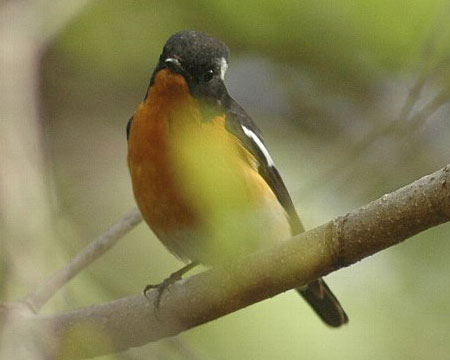むなかたが集まる
電子データベース
電子データベース
ムギマキ

| 種目 | ムギマキ (麦蒔) | 分類 |
スズメ目 ヒタキ科 キビタキ属 |
学名 | Ficedula mugimaki | 英名 | Mugimaki Flycatcher |
|---|---|---|---|---|---|---|---|
|
ムギマキ (麦蒔) |
スズメ目 ヒタキ科 キビタキ属 |
Ficedula mugimaki | Mugimaki Flycatcher |
宗像市でみられる場所・時期
宗像では,旅鳥で春秋の渡りの時期(5月ころ,10月ころ)に,島嶼部で稀に観察されることがある。本土で見る機会は乏しい。
特徴
全長13㎝でスズメより小さい。
雄は,額から顔,体上面は黒色で,眼の後方に小さい白斑がある。雨覆の一部,三列風切,次列風切の一部の外縁,外側尾羽基部葉白色で,顎から腹にかけて橙色となる。下腹から下尾筒は白色である。
雌は,頭部から体上面はオリーブ褐色で,尾羽基部は白くならない。顎から腹は淡橙褐色となり,眼の後方に白斑は出ない。
習性
平地から山林の林に飛来する。木の幹や枝上で昆虫やクモ類を捕食し,秋の渡りの時期には木の実も食べる。フライキャッチもするが,ほかの鶲類ほど頻繁ではない。
「ヒィ」と鳴き,「ピフィピフィ ピィチュリー」などと囀る。
分布
旅鳥で,ほぼ全国で観察される。特に日本海側の島嶼で多く記録されている。宗像でも同様である。春の渡り時期に比べて秋の渡り時期に観察されることが多いと言われている。
その他
ムギマキの名は,秋の麦を巻くころに現れることに由来すると言われている。
 はじめに
はじめに お問い合わせ
お問い合わせ